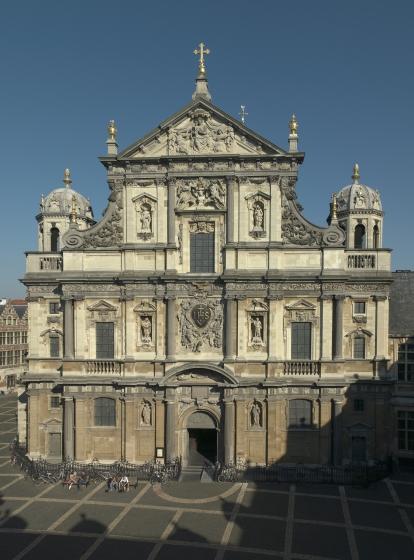Saint Charles Borromeo's Church Antwerp

Saint Charles Borromeo's Church Antwerp
Hendrik Conscienceplein
B-2000 Antwerp
Belgium
P 0032 (0)3 289 41 53
Saint Charles Borromeo's Church, a textbook example of baroque architecture in the Southern Netherlands, was built between 1614-1621 during the Twelve Years' Truce on the instructions of the devout Jesuit order. Its construction plans were drafted by members of the order: firstly by rector François d'Aguilon and subsequently brother Pieter Huyssens. Stupendous sums were spent on its decoration. Antwerp's Jesuits had good reason to call their church the marble temple.
The truly picturesque nature of this church can be seen from dozens of 17th-century depictions of its interior; and countless travel guides from the period attest to its exceptional allure for tourists. Consequently, it was a black day in the history of the church when lightning struck on 18 July 1718. The 39 ceiling paintings by Peter Paul Rubens went up in flames, as did the copious wealth of marbles in the nave. Reconstruction of the colonnaded basilica was entrusted to Jan Pieter Van Baurscheit the Elder and, three years later, the church was able to open its doors once again.
In 1773, weakening under pressure from world powers, the pope disbanded the Jesuit order. Their goods were confiscated. A few years later, their church in Antwerp was given a new designation as a centre for religious instruction. In 1803, the model saint for religious instruction, Charles Borromeo, saw his name preserved when the house of worship was designated an independent parish church following the Concordat with Napoleon.
Antwerp's Jesuits scarcely left a square foot of space untouched in their artistic project to communicate their faith. Each bay from the ceiling, the side aisles and the galleries was employed as a compartment to house a tableau of Christian religious history. For Rubens, the religious fervour of the Society of Jesus provided an extraordinary opportunity to produce an impressive series of ceiling paintings. According to the agreement into which he entered in 1620, Rubens had to prepare his own designs, could have them executed by his studio and, if necessary, could make personal corrections to them subsequently. The entire ensemble was completed within one and a half years, before the church was consecrated. For six months, the 21-year-old Anthony van Dyck was Rubens' most important assistant.
Approximately half of the larger colour sketches in oils and preliminary studies in grisaille have been preserved, distributed throughout art collections across the world. Since the disastrous fire of 1718, these works, together with drawings by a number of travellers from the beginning of the 18th century, constitute the most important source of knowledge. The admiration of an envoy of King James I resulted in Rubens' commission to paint the ceiling of Banqueting House in the renovations for Whitehall Palace in London in 1634. Together with its wealth of marbles, these unique cycles put this Jesuit church in Antwerp firmly on the map for sightseeing.
CC BY (Creative Commons 4.0)
